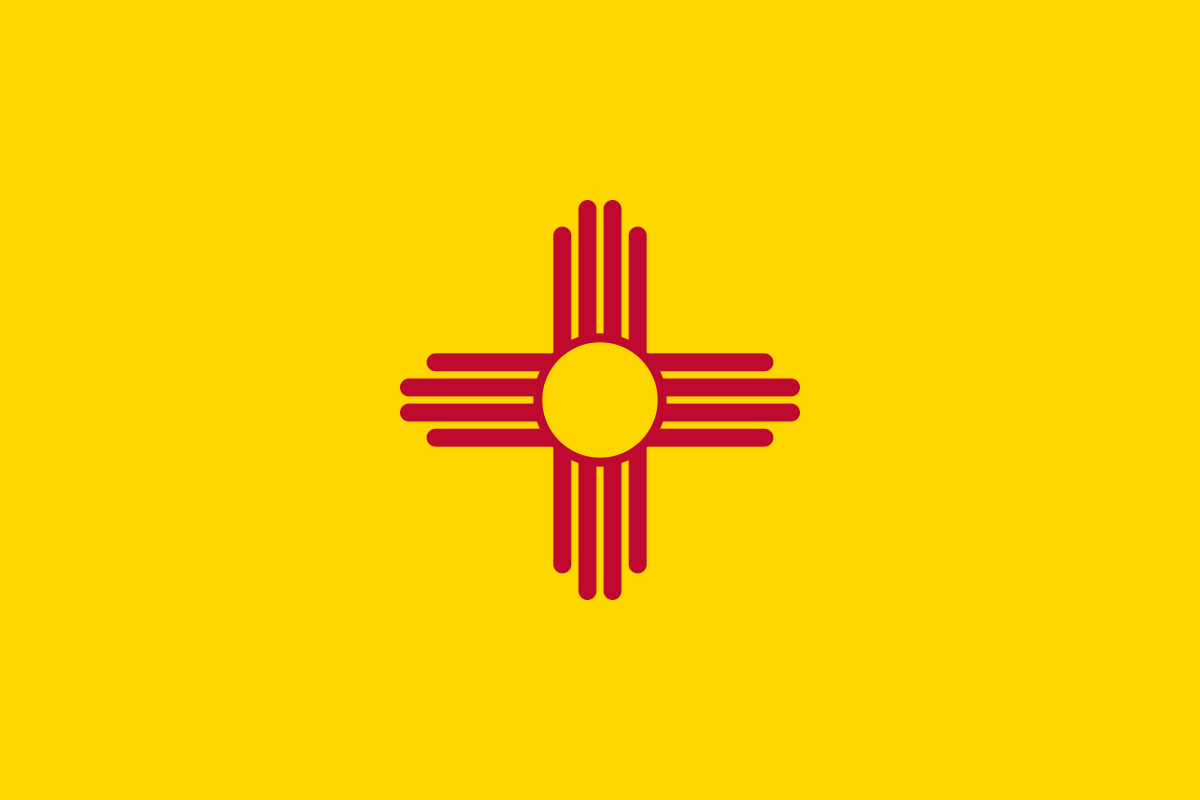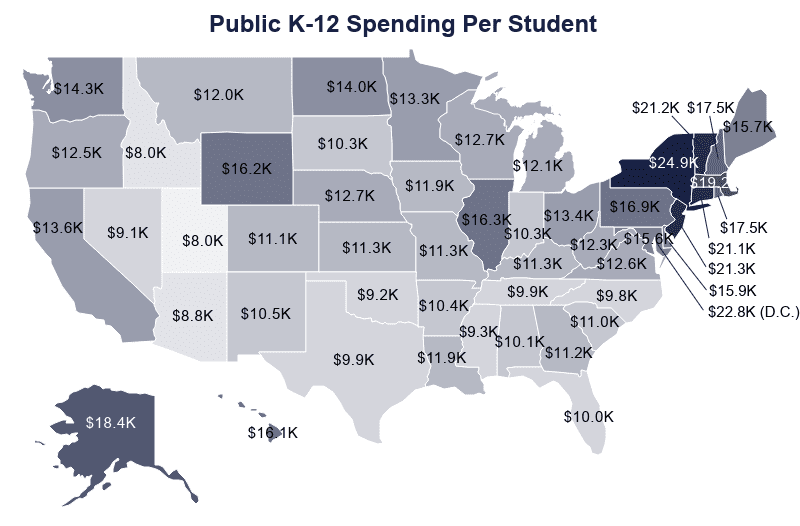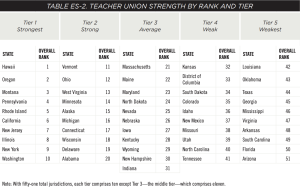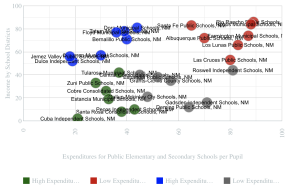Linguo Ren’s Education Project


The New Mexico Public Education Department partners with educators, communities, and families to ensure that ALL students are healthy, secure in their identity, and holistically prepared for college, career, and life. Students in New Mexico are engaged in a culturally and linguistically responsive educational system that meets the social, emotional, and academic needs of ALL students. – New Mexico Public Education Department
Total Public School Student population
318,608 students (Silva, 2021)
Total State Public Education Budget & Average Per Pupil Expenditure (Hanson, 2022)
New Mexico K-12 schools spend $9,987 per pupil for a total of $3.33 billion each year. New Mexico K-12 schools rank 40th in spending and 38th in funding.

- New Mexico K-12 schools receive $540.1 million or $1,619 per student from the federal government.
- State funding: $2.76 billion or $8,276 per pupil.
- Local funding totals $734.9 million or $2,203 per pupil.
- Expenditures are equivalent to 3.62% of taxpayer income.
- Federal education funding is equivalent to 0.59% of the state’s taxpayer income.
- State and local funding is equivalent to 3.80% of New Mexico’s taxpayer income.
- Federal education funding is equivalent to 0.59% of the state’s taxpayer income.
- Funding for K-12 education in New Mexico totals $4.04 billion or $12,099 per pupil.
- The difference between spending and funding is $704.5 million or $2,112 per pupil.
Per Pupil Expenditure
(Click the image to see more details)
Schools in the United States spend an average of $12,624 for each student. The U.S. has the fifth-highest amount per student among the 37 other countries in the Organization for Economic Co-operation and Development (Hanson, 2022)
Per Pupil Expenditure in New Mexico (McCann, 2021).
- Funding for K-12 education in New Mexico: $12,099 per pupil.
- Mosquero Municipal Schools have the highest expenditures for public elementary and secondary Schools per Pupil: $47,806
- Rio Rancho Public Schools have the lowest expenditures for public elementary and secondary Schools per Pupil: $8,567
Public v. Private School Attendance (State of Education, 2018)

- Total public school student enrollment was the highest during 2014–15. There were more than 340,000 students in New Mexico public schools. After that, the total student enrollment declined to approximately 338,000 students during 2016–17.
- Private school enrollment in New Mexico has stopped growing since 2011 when there were 22,680 students in private institutions. In 2015, there were 22,230 students enrolled in approximately 170 New Mexico private schools. That is roughly 6 percent of the state’s total school-age population.
- Public school enrollment has not changed in 2021 compared with 2020.
Student demographics (GRADUATION DATA, 2022)
Cohort of 2021
| Cohort of 2021 | |||
| N | % | ||
| All Students | 24999 | 100.0% | |
| Male | 12537 | 50.2% | |
| Female | 12462 | 49.8% | |
| African American | 564 | 2.3% | |
| Caucasian | 5709 | 22.8% | |
| Asian | 462 | 1.8% | |
| Hispanic | 15494 | 62.0% | |
| Native American | 2770 | 11.1% | |
| English Learners | 7428 | 29.7% | |
| Economically Disadvantaged | 16052 | 64.2% | |
| Students with Disabilities | 3861 | 15.4% | |
- Nearly 16% of students in New Mexico public schools are ESL students. There are dual language programs that help those students develop their English skills by learning material in two languages.
- Compared to 19.5 percent in 2018, New Mexico’s poverty rate in 2019 was 18.2 percent. However, New Mexico was still the third-highest in the country. The national rate was 12.3 percent.
Graduation Rates
| Group | GradRate |
| All | 76.8 |
| Male | 72.6 |
| Female | 81.1 |
| African American | 74.5 |
| Caucasian | 80.5 |
| Asian | 89.2 |
| Hispanic | 76.1 |
| Native American | 71.5 |
| English Language Learners | 74.7 |
| Economically Disadvantaged | 72.5 |
| Students with Disabilities | 68 |
Accountability measures (A Guide, 2020)
New Mexicos Assessment System (Click to see the video )
NM Vistas has 13 measures from four indexes in the table below. The points for each measure are also summed together to calculate an overall score for every school
| ESSA Indicator | Elementary and Middle School | High School |
|---|---|---|
| Academic Achievement Indicators | ||
| Math Proficiency | 15 | 12.5 |
| Reading Proficiency | 15 | 12.5 |
| Academic Progress Indicators | ||
| Math Growth | 20 | 15 |
| Reading Growth | 20 | 15 |
| English Language Proficiency Indicators | ||
| English Learner Progress | 10 | 5 |
| School Quality/Student Success Indicators | ||
| Science Proficiency | 5 | 5 |
| Regular Attendance | 5 | 5 |
| College and Career Readiness | — | 10 |
| Educational Climate Survey | 10 | 5 |
| Growth in 4-Year Rate | — | 5 |
| Graduation Rate Indicators | ||
| 4-Year Graduation Rate | — | 5 |
| 5-Year Graduation Rate | — | 3 |
| 6-Year Graduation Rate | — | 2 |
| Total Points | 100 | 100 |
Consequences for failing to meet standards—for students, teachers, administrators, and schools (Accountability, Support, 2019)
Under ESSA, New Mexico is committed to supporting LEAs and their CSI schools to meet exit criteria in the form of providing additional accountability, progress monitoring tools, evidence-based interventions, additional federal funding, and targeted investment opportunities. – New Mexico State ESSA Plan
Schools & Administrators:
- For those schools that fail to meet the criteria, within three years, the SEA will ask for more rigorous interventions for LEAs and their CSI schools. If the schools still do not meet one of the criteria after three years, LEAs would be required to participate in a more rigorous intervention. More details can be found here.
Teachers:
Click the title to read the related News: New Mexico Teachers Resist a State Official’s Plan for Evaluating Them
Students:
Click the title to read the related News: Most N.M. students fail to meet benchmarks
Testing or proficiency graduation requirements (Hathaway, 2021)
 (More details to be found here)
(More details to be found here)
Related News:
https://natponline.com/news/new-mexico-will-not-release-test-results-due-to-low-participation/
Adoption of Common Core (State Standards, n.d.)
- The education initiative known as Common Core was first adopted in some states starting in 2010. Kentucky is the first state that adopts Common Core. 46 states passed laws adopting the Common Core standards in their schools.
- The New Mexico Common Core State Standards (NMCCSS) were first implemented in the state in the 2011-2012 school year. New Mexico wished to have full implementation by 2015. The Next Generation Science Standards (NGSS), also known as NM STEM Ready Standards, were implemented by the state in 2018.
Click here to find the standards by subject
Adoption of Next Generation Science Standards (Nott, 2017)
- New Mexico planned to fully implement Next Generation Science Standards before the end of 2020.
- “It’s time to reform,” according to Public Education Secretary-designate Christopher Ruszkowski
- The New Mexico Education Department will include about a half-dozen additional New Mexico-specific science standards
Click here to find more details
Number of Charter Schools and Percentage of Students Served (Public Charter, n.d.)
The New Mexico State Legislature approved the state’s charter school law in 1993.
25,700 Students
99 Charter Schools
Charter school students are roughly 7.53 percent of total public school enrollment in New Mexico
Average Teacher Salary (Public School, 2022)
- The average Public School Teacher salary in New Mexico is $55,541 in 2022. The range of the salary normally falls between $48,483 and $64,132.
- Salary can range widely based on the city and many other significant factors such as education, certifications, additional skills, and the number of years teachers have spent in your profession.
Presence of Teachers Unions/Collective Bargaining (Winkler et al., 2012)

New Mexico Teacher Union Strength Rank in the U.S. :
- Overall Rank: 37th
- Area 1: Resources & Membership: 46th
- Area 2: Involvement in Politics: 32nd
- Area 3: Scope of Bargaining: 35th
- Area 4: State Policies: 29th
- Area 5: Perceived Influence: 8th
More details can be found here
Merit pay for teachers (Burgess, 2018)
- New Mexico governor announces a $5K-$10K teacher merit pay plan. Gov. Susana Martinez and the New Mexico Public Education Department are pushing a new merit pay plan to reward excellent teachers with merit pay of up to $10,000.
Click here to read the related news
Teacher evaluation methods and measures (New Mexico, 2018)
Implementing a rigorous, uniform observation protocol, providing immediate constructive feedback, using meaningful student data, and other multiple measures will provide valuable information to aid the professional development and growth of each teacher and principal. – New Mexico Teacher Evaluation System
- The NMTEACH Educator Effectiveness system is used to build up a framework for consistent improvement and professional growth for teachers and administrators.
- The NMTEACH system was established to make sure that each student receives equitable access to an effective principal and teacher each day when they are in school.

More information can be found here
To Learn More about New Mexico Education System:
New Mexico Education Department NEWS RELEASES
The Santa Fe New Mexican
Education Week
Data Analysis:
Based on the data you’ve collected, why do inequalities persist in your state? What evidence did you see of the state addressing or overcoming inequities?
The New Mexico public school system does not have a good reputation. In fact, in many rankings, the New Mexico public school system is ranked one of the worst states for schooling in the United States. One of the most significant reasons is that New Mexico public schools do not have enough funding. According to EducationData.org, New Mexico K-12 Schools spend $9,987 for each student and a total of $3.33 billion every year, and it ranks 40th in spending and 38th in funding (Hanson, 2022). Some states such as New York spend $25,520—this is nearly three times bigger than New Mexico’s spending. This is happening because the funding comes from property taxes, and New Mexico’s poverty rate is the third-highest in the country (Moskowitz, 2021). The lack of funding deeply impacts New Mexico from hiring good teachers, building academic facilities, to establishing education programs. Even within Mexico, there is a huge funding difference between rich school districts and poor ones. For example, Mosquero Municipal Schools have five times more funding than Rio Rancho Public Schools (McCann, 2021). This circumstance further exacerbates the inequality.
To overcome the funding issues and improve the education quality, the New Mexico Education Department has to take full advantage of existing limited funding: implement many education standards and have strict supervision. For example, in 2011, New Mexico started to use an aggressive teacher evaluation system (Frosch, 2013). If the schools or the teachers fail to meet the standard, there will be rigorous intervention from the education department. Also from 2011 to 2012, the New Mexico Common Core State Standards were implemented (State Standards, n.d.). What’s more, New Mexico planned to fully implement Next Generation Science Standards before the end of 2020 (Nott, 2017). Even though the department is extremely ambitious, the effectiveness of those actions is still questionable. Some of the policies such as the aggressive teacher evaluation system have received critique. Ms. Skandera, a teacher from New Mexico, mentioned that the system has so much weight on the test score, and it forces teachers to spend most of their time helping students prepare for tests (Frosch, 2013). Ms. Skandera spoke out many educators’ minds.
To test whether the actions the New Mexico Education Department made are meaningful and useful takes time, but it is necessary to understand and realize the education existing funding issue in New Mexico—this is not a problem that can be solved solely by the education department.
Describe and analyze one particular trend or education-specific event in your state. Make sure to contextualize this trend or event within the big picture you’ve created from your data analysis.
New Mexico’s historic investment in educator pay will raise the average statewide teacher salary to $64,006, putting it among the highest among states in the Southwest, according to Gov. Michelle Lujan Grisham’s office. There are three measures. The first one will increase the base pay of teachers by $10,000 every year. The second one is a 7 percent increase in salary for education workers. The third measure is to raise the teacher’s minimum wage to $15 each hour. Along with those policies, Gov. Michelle Lujan Grisham also signed the bill that will enable teachers to be back at work after retiring for three months.
New Mexico faces the same challenge of losing teachers as all other states in the U.S. during the pandemic. Covid-19 deeply decreases teachers’ desire and commitment to teaching due to the frustration and anxiety of teaching online—many current teachers decide to quit teaching while there are not enough new teachers to step in. The purpose of introducing those new bills is to recruit and retain teachers and education workers especially those on the lower side of the salary range.
This is the New Mexico Education Department’s commitment to improving its education quality after many years of being one of the worst states for schooling. Even though the education department does not have sufficient funding as many other states, the education department is still willing to increase the benefits of teachers in order to attract a lot of excellent teachers. Those new policies and policies from recent years such as a new merit pay plan are the progress the New Mexico Education Department has made to improve its education quality.
—————————————————————————————-
References
Accountability, Support, and Improvement for Schools. (2019, February). Retrieved May 9, 2022, from https://webnew.ped.state.nm.us/wp-content/uploads/2019/02/NM-PED-Amendments-to-ESSA-Section-4.pdf
Burgess, K. (2018, January 18). New Mexico governor, PED unveil $5K-$10K teacher merit pay plan. Retrieved May 9, 2022, from https://www.lcsun-news.com/story/news/local/new-mexico/legislature/2018/01/18/new-mexico-governor-ped-unveil-5-k-10-k-teacher-merit-pay-plan/1045237001/
Contreras, R. (2015, October 30). Most N.M. students fail to meet benchmarks. Retrieved May 9, 2022, from https://www.daily-times.com/story/news/education/2015/10/31/new-mexico-students-fail-meet-benchmarks/74924742/
Frosch, D. (2013, December 17). New Mexico Teachers Resist a State Official’s Plan for Evaluating The. The New York Times. https://www.nytimes.com/2013/12/18/us/a-push-for-teacher-accountability-meets-resistance-in-new-mexico.html
Garcia, E. (2021, October 5). New Mexico will not release test results due to low participation. Retrieved May 9, 2022, from https://natponline.com/news/new-mexico-will-not-release-test-results-due-to-low-participation/
GRADUATION DATA. (2022, April 13). Retrieved May 9, 2022, from https://webnew.ped.state.nm.us/bureaus/accountability/graduation/
A Guide to the New Mexico Public Education Department’s School Accountability System. (2020, April 17). Retrieved May 9, 2022, from https://webnew.ped.state.nm.us/wp-content/uploads/2020/04/New-Mexico-Vistas-Technical-Guide-SY-2018-19-1.pdf
Hanson, M. (2022, March 15). U.S. Public Education Spending Statistics. EducationData.org. Retrieved May 9, 2022, from https://educationdata.org/public-education-spending-statistics
Hathaway. (2021, May 27). High School Graduation Requirements. https://www.nmlegis.gov/handouts/ALESC%20052721%20Item%206%20.1%20-%20Brief%20High%20School%20Graduation%20Requirements.pdf
McCann, A. (2021, August 3). Most & Least Equitable School Districts in New Mexico. Retrieved May 9, 2022, from https://wallethub.com/edu/e/most-least-equitable-school-districts-in-new-mexico/77110
Moskowitz, R. (2021, February). Poverty in New Mexico: 2019. Retrieved May 9, 2022, from https://www.dws.state.nm.us/Portals/0/DM/LMI/Poverty_in_NM_2019.pdf
New Mexico Teacher Evaluation System. (2018, August). Retrieved May 9, 2022, from https://www.nctq.org/dmsView/New-Mexico-Teacher-Evaluation-System-Technical-Guide-2017-18
NM PED LEADERSHIP. (2022, March 31). New Mexico Public Education Department. Retrieved May 9, 2022, from https://webnew.ped.state.nm.us/bureaus/nmpedleadership/
Nott, R. (2017, October 25). New Mexico to adopt Next Generation Science Standards in full, with state-specific additions. Retrieved May 9, 2022, from https://www.santafenewmexican.com/news/education/new-mexico-to-adopt-next-generation-science-standards-in-full-with-state-specific-additions/article_dadea58f-3123-576b-94e6-b9f0d3e39afa.html
Pollard, J. (2022, March 19). Experienced teachers could see smaller pay increases in New Mexico. Retrieved May 9, 2022, from https://www.santafenewmexican.com/news/education/experienced-teachers-could-see-smaller-pay-increases-in-new-mexico/article_db11fb84-9a46-11ec-b401-b39dd8c53c03.html
Public Charter Schools of New Mexico. (n.d.). The Santa Fe New Mexican. Retrieved May 9, 2022, from https://publiccharterschoolsofnewmexico.org/
Public School Teacher Salary in New Mexico. (2022, April 26). Salary.com. Retrieved May 9, 2022, from https://www.salary.com/research/salary/benchmark/public-school-teacher-salary/nm
Silva, C. L. (2021, December 27). New Mexico school enrollment remains steady after nationwide drop. Retrieved May 9, 2022, from https://www.currentargus.com/story/news/education/2021/12/27/new-mexico-school-enrollment-remains-steady-after-nationwide-drop/8982051002/
State of Education in New Mexico 2018. (2018). NewMexicoKidsCAN. Retrieved May 9, 2022, from https://nmkidscan.org/wp-content/uploads/sites/15/2017/09/SoE-NM-WEB.pdf
State Standards and Core Instructional Materials. (n.d.). Retrieved May 9, 2022, from https://www.aps.edu/curriculum-and-instruction/state-standards
Winkler, A. M., Scull, J., & Zeehandelaar, D. (2012, October). HOW STRONG ARE U.S. TEACHER UNIONS? A STATE-BY-STATE COMPARISON. Retrieved May 9, 2022, from https://files.eric.ed.gov/fulltext/ED537563.pdf

